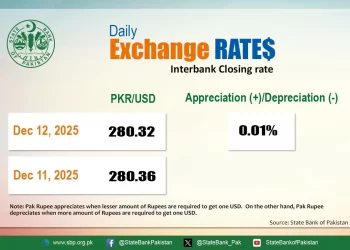SYDNEY: The Australian dollar held near six-month peaks on Friday as markets sharply narrowed the odds on US rate cuts, while the New Zealand dollar was sunk by bets on even steeper cuts at home.
The Aussie stood at $0.6762, after touching a top of $0.6799 overnight.
Support lies around $0.6714, with resistance up at a high from last December at $0.6871.
The kiwi dollar wallowed at $0.6087, having shed 0.9% for the week so far.
Support lies at $0.6065 and $0.6018. Market action was dominated by wild swings in the Japanese yen, which surged against the greenback after a surprisingly soft US inflation report, sparking speculation about government intervention.
That saw the Aussie peel back to 107.55 yen, after touching a 33-year high of 109.67 overnight.
The benign US price data also saw markets scale back the chance of a rate hike from the Reserve Bank of Australia (RBA).
Futures now imply a 14% chance of an RBA hike at its August meeting, compared to 40% a couple of weeks ago.
Markets still expect scant chance of an easing until next July, while pricing in at least two US rate cuts this year.
Thus while Australian 10-year bond yields had rallied to a two-week low of 4.322%, the spread over Treasuries still widened to 14 basis points. Back in April, that spread was at -40 basis points.
Australian dollar flies high on kiwi, yen as rate outlooks diverge
This swing has seen the Aussie’s trade-weighted index (TWI) climb for four weeks in a row to hit a two-year high.
“The increase in the TWI could be getting to the point where it might exert a little downward pressure on the RBA’s GDP and inflation forecasts on a one-year plus horizon,” noted Adam Boyton, head of Australian economics at ANZ.
Much will depend on the second-quarter consumer price report due on July 31, where inflation is expected to edge higher.
“We maintain our call for the RBA to be on hold at 4.35% until a 25bp cut in February 2025,” said Boyton. “But we acknowledge a strong CPI print would raise the risk of the RBA hiking in August.”
Across the Tasman, spreads have swung the other way after the Reserve Bank of New Zealand (RBNZ) wrongfooted markets by opening the door to easing at a meeting this week.
That saw two-year swap rates plunge 39 basis points for the week, the biggest drop since early 2011.
Markets now imply a 50-50 chance the central bank could cut as early as August, while pricing in 32 basis points of easing by October and about 150 basis points by April.
SYDNEY: The Australian dollar held near six-month peaks on Friday as markets sharply narrowed the odds on US rate cuts, while the New Zealand dollar was sunk by bets on even steeper cuts at home.
The Aussie stood at $0.6762, after touching a top of $0.6799 overnight.
Support lies around $0.6714, with resistance up at a high from last December at $0.6871.
The kiwi dollar wallowed at $0.6087, having shed 0.9% for the week so far.
Support lies at $0.6065 and $0.6018. Market action was dominated by wild swings in the Japanese yen, which surged against the greenback after a surprisingly soft US inflation report, sparking speculation about government intervention.
That saw the Aussie peel back to 107.55 yen, after touching a 33-year high of 109.67 overnight.
The benign US price data also saw markets scale back the chance of a rate hike from the Reserve Bank of Australia (RBA).
Futures now imply a 14% chance of an RBA hike at its August meeting, compared to 40% a couple of weeks ago.
Markets still expect scant chance of an easing until next July, while pricing in at least two US rate cuts this year.
Thus while Australian 10-year bond yields had rallied to a two-week low of 4.322%, the spread over Treasuries still widened to 14 basis points. Back in April, that spread was at -40 basis points.
Australian dollar flies high on kiwi, yen as rate outlooks diverge
This swing has seen the Aussie’s trade-weighted index (TWI) climb for four weeks in a row to hit a two-year high.
“The increase in the TWI could be getting to the point where it might exert a little downward pressure on the RBA’s GDP and inflation forecasts on a one-year plus horizon,” noted Adam Boyton, head of Australian economics at ANZ.
Much will depend on the second-quarter consumer price report due on July 31, where inflation is expected to edge higher.
“We maintain our call for the RBA to be on hold at 4.35% until a 25bp cut in February 2025,” said Boyton. “But we acknowledge a strong CPI print would raise the risk of the RBA hiking in August.”
Across the Tasman, spreads have swung the other way after the Reserve Bank of New Zealand (RBNZ) wrongfooted markets by opening the door to easing at a meeting this week.
That saw two-year swap rates plunge 39 basis points for the week, the biggest drop since early 2011.
Markets now imply a 50-50 chance the central bank could cut as early as August, while pricing in 32 basis points of easing by October and about 150 basis points by April.









